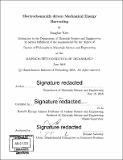Electrochemically driven mechanical energy harvesting
Author(s)
Kim, Sangtae, Ph. D. Massachusetts Institute of Technology
DownloadFull printable version (10.82Mb)
Other Contributors
Massachusetts Institute of Technology. Department of Materials Science and Engineering.
Advisor
Ju Li.
Terms of use
Metadata
Show full item recordAbstract
Efficient mechanical energy harvesters enable various wearable devices and may also act as auxiliary energy supply to isolated area. In this thesis, I present a novel class of mechanical energy harvesters based on stress-voltage coupling in electrochemically alloyed electrodes. The device consists of two identical Li-alloyed Si as electrodes, separated by electrolyte-soaked polymer membranes. Bending-induced asymmetric stresses generate chemical potential difference, driving lithium ion flux from the compressed to the tensed electrode to generate electric current. Unbending the device reverses the ion flux, generating electrical current in the opposite direction. The thermodynamic analyses reveal that the ideal energy-harvesting efficiency of this device is dictated by the Poisson's ratio of the electrodes. For the thin-film-based energy harvester used in this study, the device has achieved the overall efficiency of 0.6% and a generating capacity of 15%. The device also presents unique characteristics over the existing type of mechanical energy harvesters. Compared to piezoelectric or triboelectric generators, the prototype demonstrates low internal impedance of the order of 300[omega] as opposed to 100M[omega] in the other two types, and continuous electric current of the order of 3 seconds as opposed to 50ms in the other two types. From kinetics analysis, we show that the device's electric current generation is limited by lithium diffusion inside the LixSi electrode for sufficiently thick electrodes and by electrolyte diffusion for thin electrodes below 400nm. Tuning the current peak widths between 5s and 22s was demonstrated experimentally. The framework developed in the kinetics analyses also suggests that the device may be used as a spectroscopic tool to measure lithium diffusivity inside electrochemical alloys. The experimentally observed kinetics suggests lithium diffusivity on the order of 10-¹⁰cm² /s in Li₃.₁Si. The device demonstrates a practical use of stress-composition coupling in electochemically active alloys to harvest low-grade mechanical energies from various lowfrequency motions, such as everyday human activities. The analyses present the quantitative strategies to optimize the device in terms of its total energy output, kinetic behavior and ultimately the design principles for an energy harvester optimized for harvesting a specifically targeted frequency motion.
Description
Thesis: Ph. D., Massachusetts Institute of Technology, Department of Materials Science and Engineering, 2016. Cataloged from PDF version of thesis. Includes bibliographical references (pages 113-120).
Date issued
2016Department
Massachusetts Institute of Technology. Department of Materials Science and EngineeringPublisher
Massachusetts Institute of Technology
Keywords
Materials Science and Engineering.